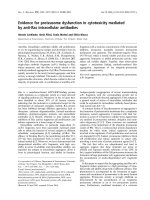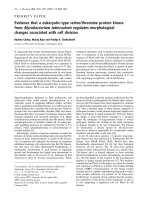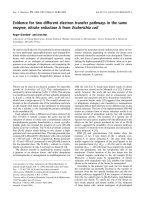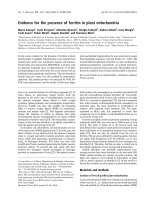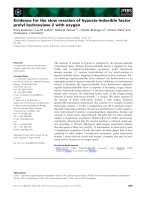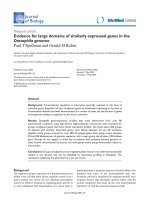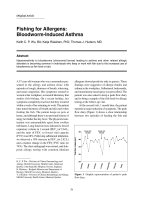Báo cáo y học: " Evidence for intelligent (algorithm) design" doc
Bạn đang xem bản rút gọn của tài liệu. Xem và tải ngay bản đầy đủ của tài liệu tại đây (52.17 KB, 3 trang )
Genome Biology 2006, 7:322
comment
reviews
reports
deposited research
interactions
information
refereed research
Meeting report
Evidence for intelligent (algorithm) design
Balaji S Srinivasan*
†
, Chuong B Do
‡
and Serafim Batzoglou
‡
Addresses: *Department of Electrical Engineering, Stanford University, Stanford CA 94305, USA.
†
Department of Developmental Biology,
Stanford University, Stanford CA 94305, USA.
‡
Department of Computer Science, Stanford University, Stanford CA 94305, USA.
Correspondence: Serafim Batzoglou. Email:
Published: 25 July 2006
Genome Biology 2006, 7:322 (doi:10.1186/gb-2006-7-7-322)
The electronic version of this article is the complete one and can be
found online at />© 2006 BioMed Central Ltd
A report on the 10th annual Research in Computational
Molecular Biology (RECOMB) Conference, Venice, Italy, 2-5
April 2006.
More than 700 computational biologists convened in beautiful
Venice in early April for RECOMB 2006, the 10th annual
Conference on Research in Computational Molecular
Biology. After 40 talks, 6 keynote lectures, 180 posters, and
at least two cameos by the Riemann zeta function, several
emerging trends in computational biology are apparent.
First, there has been a strong shift towards empirical studies
of molecular evolution and variation, with approximately
25% of the papers in this broad area. We expect that this
number can only increase in the near future, given the
ENCODE project [ and
the forthcoming release of several new eukaryotic genomes.
Second, there is a resurgence of interest in two of the oldest
problems in computational biology: RNA folding and protein
sequence alignment. The interest in noncoding RNAs
(ncRNAs) is driven by experiment: recent work on RNA
interference (RNAi), microRNAs, ribozymes, and the rest of
the ‘modern RNA world’ has once again stimulated interest
in the classical problems of ncRNA identification and fold
prediction. Advances in protein sequence alignment draw on
the development of new algorithmic and machine-learning
techniques for principled estimation of gap penalties (the
penalty for inserting a gap in the alignment to improve it)
and the rigorous incorporation of non-local similarity mea-
sures that move beyond residue-residue similarity.
Interest in classic areas such as protein structure and folding
remains strong, with several papers tacitly or explicitly moti-
vated by the coming flood of data promised by structural
genomics. Many of the other mainstays of computational
biology were also represented at the conference, including
old favorites such as expression analysis and genome evolu-
tion, as well as the newer areas of data integration and
network alignment. Notable by their absence were papers on
genome assembly and human single-nucleotide polymor-
phism (SNP) variation; this is likely to be a fluke rather than
a trend, however, given the impending deluge of data from
high-throughput sequencing and resequencing projects. We
have selected a few of the talks that particularly caught our
eye out of the many excellent ones given at the conference.
Focus on ncRNA folding
One of the highlights of the conference was the demonstra-
tion by Ydo Wexler (Technion-Israel Institute of Technology,
Haifa, Israel) of a quadratic time algorithm for RNA folding,
a result that deservedly won a special mention award. For
several decades, RNA folding algorithms had running times
that scaled with at least the cube of the length of the RNA
sequence. This O(L
3
) time complexity worsens further if
pseudoknots are involved in the folding model. By combin-
ing a simple ‘triangle inequality’ heuristic with empirical val-
idation of the ‘polymer zeta’ behavior of RNA folding, Wexler
and colleagues developed an O(L
2
) average time algorithm
for RNA folding, a result which makes high-throughput
ncRNA prediction far more feasible.
The pseudoknot, a fold comprising two or more helical seg-
ments connected by single-stranded loops, was the subject of
a talk by Banu Dost (University of California, San Diego,
USA), who presented a new algorithm for aligning a subset
of ncRNAs with computationally tractable pseudoknots to a
database of known ncRNA sequences. Sequences that inter-
act to serve a structural or biochemical function often show
coevolution. In this regard, Jeremy Darot (University of
Cambridge, UK) presented a general probabilistic graphical
model for detecting interdependent evolution between sites
in nucleic acid and protein sequences, which he applied to
the problem of identifying secondary and tertiary structure
interactions in tRNA.
Interaction networks and microarray analysis
The broad area of functional genomics encompasses
methods for the prediction of gene function and interaction.
Talks covered the inference and comparison of protein-
interaction networks, and the statistical issues associated
with the detection of functional enrichment in microarray
data. One of us (B.S.S) described an algorithm for integrat-
ing a number of different predictors of protein interaction
without making assumptions about statistical dependence.
He showed that this approach revealed hidden interactions
that would not have been found without data integration,
and used the method to produce probabilistic protein-inter-
action networks for 11 microbes. Benny Chor (Tel-Aviv Uni-
versity, Tel-Aviv, Israel) presented work on graphs of
metabolic reactions from different species, showing that a
taxonomy inferred from network-based characters corre-
sponded fairly well to the known consensus phylogeny.
The problem of comparing large collections of networks from
different species motivates work on network alignment,
whose goal is to detect conserved modules between networks.
By analogy with the existing theory for sequence alignment,
Mehmet Koyutürk (Purdue University, West Lafayette, USA)
presented an asymptotic theory for estimating the statistical
significance of network alignments, with respect to certain
classes of large random networks. Developing a version of
this theory applicable to alignments of few proteins, which
are more common in practice, is an open problem.
Steffen Grossmann (Max Planck Institute for Molecular
Genetics, Berlin, Germany) presented an improved statistic
for estimating the functional enrichment of gene sets based
on Gene Ontology (GO) that takes account of the complex
parent-child dependencies in the GO hierarchy (this statistic
is implemented in the Ontologizer package available at
[ Stefanie
Scheid (Max Planck Institute for Molecular Genetics) pre-
sented a novel permutation-filtering technique for the detec-
tion of differentially expressed genes in microarray analysis.
Her method filters the results of a naive data permutation to
estimate a more accurate null distribution, and her work is
implemented in the Twilight package available online
[].
Parameter estimation in protein sequence
alignment
Two speakers addressed the issue of estimating parameters
such as substitution scores and gap penalties for protein
sequence alignment. John Kececioglu (University of Arizona,
Tucson, USA) provided a solution to the ‘inverse sequence
alignment’ problem, where one estimates parameter values
from a training set of alignments. He described a linear pro-
gramming algorithm for determining a set of alignment
parameters under which every example alignment in a given
training set is guaranteed to be nearly optimal with respect
to that parameter set. The algorithm can learn both residue
substitution and gap scores simultaneously, and it will be
interesting to see how the resulting parameters perform
when used to make new alignments.
One of us (C.B.D) introduced pair-conditional random fields
for incorporating non-local sequence similarities (such as
hydropathy) into the alignment scoring framework. As such
similarities are functions of peptide windows of variable
length rather than of individual residues, they cannot easily
be incorporated into standard methods based on hidden
Markov models (HMMs) for sequence alignment without
heuristics. The resulting algorithm, CONTRAlign (source code
available online [ />achieves the highest cross-validated pairwise protein align-
ment accuracies to date.
Protein structure, dynamics and identification
Perhaps the biggest obstacle to deriving insights from
protein structure is the sheer size and complexity of a
typical polypeptide. Addressing the problem of protein
structure alignment, Wei Xie (University of Illinois at
Urbana-Champaign, USA) and Jinbo Xu (Massachusetts
Institute of Technology, Cambridge, USA) manage this com-
plexity by focusing on maps of intra-protein contacts. Xie
presented work on aligning structures by overlapping their
contact maps, by developing a brand-and-reduce algorithm
that allows rapid superposition of structurally homologous
proteins. By analogy with sequence alignment, Xu presented
a polynomial time-parametric algorithm for aligning a
protein represented by a contact map to another protein rep-
resented by a contact map or an interatomic distance matrix.
Many scientists are interested not just in alignments of
stable protein structures, but also in the dynamics of the
folding process. Chakra Chennubhotla (University of Pitts-
burgh, Pittsburgh, USA) reduced the complexity of an all-
atom protein simulation by calculating a low-rank,
eigenmode-based approximation to the molecular dynamics
that is designed to preserve certain stochastic properties of
the original protein. Shawna Thomas (Texas A&M Univer-
sity, College Station, USA) took a technically different but
conceptually similar approach by approximating a protein as
a chain of rigid bodies and then sampling its conformation
space with a probabilistic roadmap method imported from
motion planning for robotics (for further details, see the
parasol website [ />The ‘roadmap’ in the protein context contains thousands of
feasible folding pathways.
322.2 Genome Biology 2006, Volume 7, Issue 7, Article 322 Srinivasan et al. />Genome Biology 2006, 7:322
The ultimate purpose of protein-folding simulation (as
distinct from protein-structure prediction) is to use the
observed dynamics to yield insight into aspects of protein
biochemistry, such as cooperativity or macromolecular
assembly. To this end, Tsung-Han Chiang (National Univer-
sity of Singapore, Singapore) showed that the probabilistic
roadmap framework can be used to calculate the probability
of proper folding from any given protein conformation, and
then to estimate protein-folding rates.
Two speakers addressed problems of fast protein identifica-
tion by clever hashing methods. Brian Chen in collaboration
with Viacheslav Fofanov (both from Rice University,
Houston, Texas, USA) showed that one can use geometric
hashing techniques to speed up the identification of three-
dimensional structural motifs in functionally uncharacter-
ized proteins of known structure. In a different problem
domain, Nuno Bandeira (University of California, San Diego,
USA) demonstrated a rapid hashing algorithm for identify-
ing proteins from tandem mass spectrometry (MS/MS)
spectra. The input protein sample is split into two groups,
chemical modifications are applied to one group, and spectra
are obtained for both groups. Bandeira showed how using
correlations between the two spectra greatly reduces the
noise of protein identification.
Reconstructing the past
Talks on evolution and phylogenetics included richer models
of sequence evolution, new methods for tree building, and
applications of molecular evolution to questions in func-
tional genomics. On the topic of richer models for deducing
phylogeny from sequences, Yun Song (University of Califor-
nia, Davis, USA) described a method for including gene con-
version in reconstructions of SNP phylogenies (software
available online [ />existing methods typically incorporate only point mutation
and recombination as possible events. Sagi Snir (University
of California, Berkeley, USA) presented work on the infer-
ence of micro-indel events (insertions and/or deletions)
from multiple sequence alignments; the method has a time-
complexity that is exponential in the number of species, but
is linear in terms of sequence length. Miklós Csürös (Univer-
sité de Montréal, Montreal, Canada) dealt with gene evolu-
tion. He described a parametric model for gene family
evolution that models gene duplication, gene loss, and (most
significantly) horizontal gene transfer.
With respect to the general problem of building trees from
data, Constantinos Daskalakis (University of California,
Berkeley, USA) described an algorithm for calculating phylo-
genies from distance matrices (compiled from the differ-
ences between sequences), which compares favorably to
neighbor-joining on specific examples, without requiring
strong assumptions about possible model tree topologies.
Adam Siepel (University of California, Santa Cruz, USA)
addressed the problem of using molecular evolution to
detect functional elements in genomic sequences. He has
extended the phastCons program, a phylogenetic HMM
model for segmenting a genomic sequence into conserved
and nonconserved regions, by introducing lineage-specific
models which allow for simple gains or losses of constraint
along specific branches of the evolutionary tree relating the
sequences. The output of the program, called DLESS, is
available as a track on the University of California Santa
Cruz genome browser [ />Evolution also figured prominently in the only talk at the
conference given by a non-scientist. In his keynote address,
author and journalist Carl Zimmer warned of the perils of
‘genomic myopia’ and challenged computational molecular
biologists to create a model of life’s evolution that was con-
sistent with the wealth of knowledge from paleontology and
the fossil record. Given the rapid advance of bioinformatics
apparent at RECOMB 2006, we have no doubt that our
community is up to the challenge.
comment
reviews
reports
deposited research
interactions
information
refereed research
Genome Biology 2006, Volume 7, Issue 7, Article 322 Srinivasan et al. 322.3
Genome Biology 2006, 7:322


